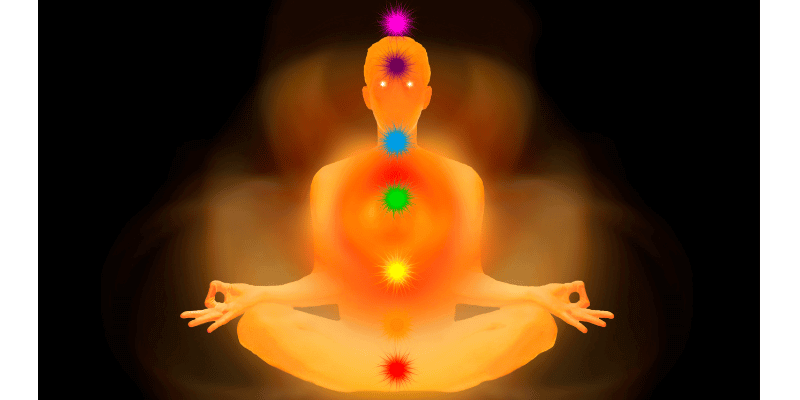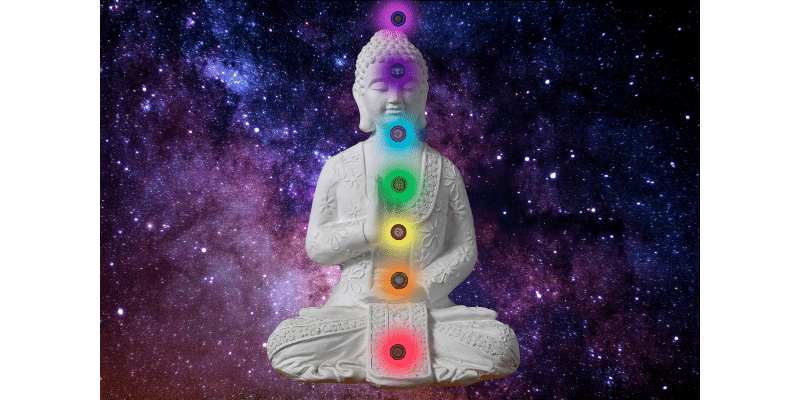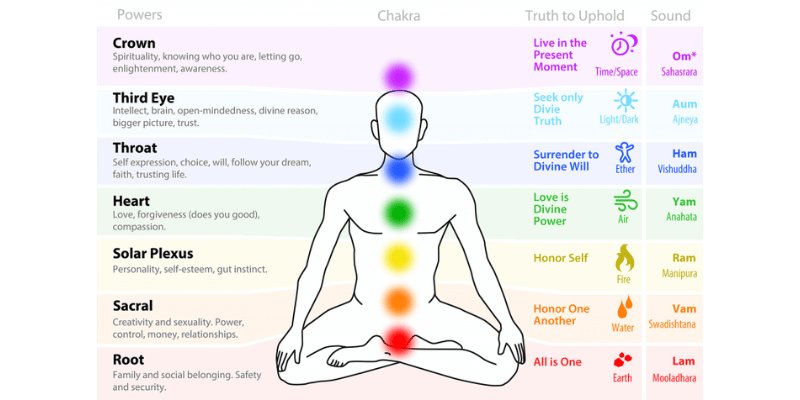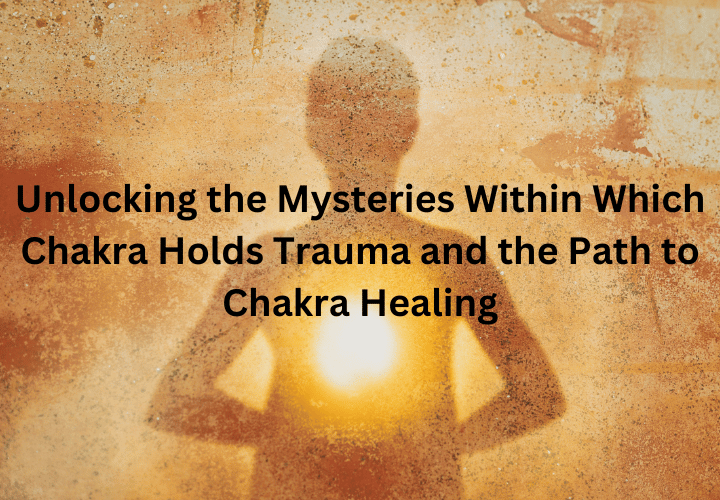Have you undergone something painful at some point in your life? Sometimes, the memory can hang on for years. This can have an impact on a person’s personality and overall well-being.
Chakra healing can positively change your body and mind. It will also spur you on for growth. Let us see which chakra holds trauma and how to deal with it.
Understanding the Role of Chakra in Holding Trauma

The experiences you have in life have energetic patterns. When you encounter a sort of trauma, the patterns are disturbed. You can compare it to a virus affecting software, or a thunderstorm affecting a network station. These events interfere with the structure of your chakra and then disturbance occurs.
Demystifying Chakras: A Brief Overview
Chakras are energy centers, or wheels, that are found in our bodies. It is a Sanskrit word that people often refer to as ‘wheels of life’. There are 7 primary chakras ones located along the spine, from the base to the top of the head.
Chakra works together to help your body and mind function at their best. When they are balanced, chakra helps radiate an energetic force. You feel calm, productive, and good about yourself. You experience vitality and personal power.
Think of a musical occasion where each of the instruments must be in tune to create balance and harmony. That is how it is with chakra. Each of the seven of them has to be aligned to promote the emotional and physical wellbeing of an individual.
Unveiling the Root Chakra: Muladhara and Its Impact on Trauma
The root chakra is the one located at the base of the spine. It is concerned with stability and security. It also governs your basic needs such as food, shelter, and water. Yes, when these needs are met, you feel grounded and secure.
However, painful memories are stored here. This includes fear and shame since childhood. Unconscious behavioral patterns (from war or disaster) are also held here. These can cause an imbalance.
Statistics show that trauma can happen in many ways, and oftentimes, it affects the root chakra. For instance, a recent study showed that individuals who had undergone traumatic stress had an imbalanced root chakra.
The Intricate Dance of Trauma and Chakra Healing

Trauma may leave a deep scar in the minds of individuals. They may also cause a chakra to be blocked or imbalanced. Chakra healing helps to unblock and balance your energy centers. These negative emotions are then released.
Energy Healing: A Holistic Approach to Trauma
Energy healing is a healing work that allows energy to flow freely throughout the body and mind. It helps to clear off any area that feels cluttered in the energy centers.
One of the energy healing methods is chi-based energy healing which is further broken down into chakra-based and meridian based. The chakra-based method uses reiki, qi-gong, therapeutic touch, quantum touch, and others to relieve blockage in the energy centers.
The meridian-based method uses acupuncture and energy medicines to rebalance the systems of the body. The second kind is the non-chi based energy healing. This one uses sound healing, flower essences, and crystal healing to clear blockage from the energy system.
According to a recent study conducted at the University of Pennsylvania, patients who received energy healing had a 50% reduction in their levels of stress. These patients affirmed that they felt relief in their physical body, mind, and soul after the healing sessions.
Another study examined the effects of energy healing on patients who had undergone PTSD. Those who received energy healing showed a significant reduction in pain, anxiety, and blood pressure. According to a survey conducted in the United States, about 3.7 million people engage in an energy-healing process related to trauma. This shows that energy healing practices are effective.
Chakra healing employs the use of reiki, meditation, and yoga to balance the chakras. Knowing which chakra holds trauma can help facilitate healing. Chakra health is important to maintain an individual’s overall well-being.
The Traumatic Event Connection: Unraveling the Past
Trauma is an emotional response to negative events that hinder an individual’s ability to cope. It can hurt one’s physical and emotional health. Traumatic experiences can affect the chakra balance in your body. It could either cause a chakra to be overactive or underactive.
Below is a tabular representation of common traumatic stressors and their chakra associations.
| Traumatic Stressor | Chakra Association |
| Physical abuse | Muladhara |
| Sexual abuse | Svadhishthana |
| Emotional neglect | Manipura |
| Abandonment | Anahata |
| Betrayal | Vishuddha |
| Violent attacks | Ajna |
| Near-death experiences | Sahasrara |
Many individuals have found chakra healing helpful in their healing journey. One woman, named Kate Hamilton-Hunter, related her experience when she attended one of her yoga classes. She was told to practice mindful breathing and then say her name. But, she couldn’t. Her throat was tight and tears started flowing. She recalled a traumatic event she had in her childhood. However, after balancing her chakras, she noticed she felt better. Now she recommends it to anyone going through the same thing.
An article editor, Eric Skarda, narrates that he came across chakra healing while editing articles at work. Before that time, he experienced disconnection from people and felt his life was a wreck till he met a healer. He discovered some of his chakras were blocked. The healer performed chakra healing on him and he noticed incredible changes over time.
Navigating Through the Chakra System: Identifying Imbalances

The chakra system helps to align energy in the body. Chakra relates to an individual’s nervous system. It is connected by Sushumna, the major energy channel of the subtle body that links the base chakra to the crown chakra. They need regular upkeep to achieve balance and openness.
Balancing Act: Chakras and their Imbalances
Here’s a brief overview of them of the 7 chakras in the body:
The first chakra is the root chakra or Muladhara which is established at the base part of your spine. It gives rise to the sense of balance and feelings of safety. The second chakra is the sacral chakra (Svadhisthana) which is below your navel. This is where your emotion stems from. The third is Manipura chakra or the solar plexus chakra which is located in your stomach and responsible for confidence. The fourth chakra is that of the heart chakra located in the center of your chest. It is responsible for the sense of love.
The fifth chakra is the throat (Vishuddha). Following its name, it is located at the throat and is responsible for communication. The sixth chakra is Ajna or third eye chakra is located between the eyebrows and is responsible for intuition. The seventh chakra is the crown chakra (Sahasrara) which is found at the top of your head and is responsible for spiritual connection.
An imbalanced chakra has negative signs that include physical symptoms such as facial problems, infection, body pain and ulcer. Then, you will start making frequent mistakes.
Chakra healing plays a major role in addressing these imbalances. It helps energy to flow, produce vitality and equilibrium. It’s a safe practice that is aimed at harmonizing all aspects of your well-being. Doing this makes you less prone to distressing situations that you may have experienced in life.
From Muladhara to Throat Chakra: Tracing the Trauma Pathway
Trauma affects all the chakra. In fact, when one chakra is hit, the others are affected. It causes them to lose balances, either making them underactive or overactive. For instance, when trauma affects the root chakra, a person starts questioning his very existence on earth. When the sacral chakra is hit maybe by sexual abuse, a person develops a distorted view of sex and questions his right to want pleasure.
When the solar chakra holds trauma, a person develops feelings of powerlessness. When trauma affects the human heart, a person may feel disconnected from others. When the throat is affected, a person is reserved and refuses to speak and cannot find his voice. When the third eye is affected by trauma, a person loses focus. When the crown of your head is hit, a person is separated from the spiritual world.
Trauma manifests in different ways in the seven chakras. In the root chakra, it may be in form of depression and paranoia. In the sacral chakra, it may be manifest in hormonal imbalances and sexual repression. In the solar plexus, it may happen in form of anxiety and digestive problems. In the heart, manifestation include consistent grief and asthma.
In the throat, it may be in form of thyroid problems, frequent cold and sore throat. In the heart, manifestation include consistent grief and asthma. In the throat, it may be in form of thyroid problems, frequent cold and sore throat. Trauma in the third eye may manifest in form of nightmares, hallucinations and mental fogginess. In the crown chakra, it may manifest in the form of migraines and dizziness.
The following steps help to heal each affected chakra:
- Root chakra: Light a red candle. Use an essential oil. Get some exercise outdoors.
- Sacral chakra. Light an orange candle. Go for a massage. Listen to some cool music.
- Solar plexus chakra: Meditation, create a mantra. Use chakra stones. Light a yellow candle.
- Heart chakra: Eat green leafy vegetables, light a green candle. Go out for a nature hike.
- Throat chakra: Light a blue candle. Practice positive affirmation. Consider singing.
- Third eye chakra: Reconnect with nature by staying by the beach. Meditation and yoga can also help.
- Crown chakra: Yoga and reiki. Positive affirmations. Light a purple candle.
Use these 7 Mantras to Heal and Clear your Throat Chakra
Here are 7 mantras to help heal and clear your throat chakra.
- The Gayatri Mantra
- Sat Nam Mantra
- Loving Kindness Mantra
- The Adi Mantra
- The Jeweled Lotus Flower Mantra
- Healing Kundalini Mantra
- So Hum Mantra
Practical Steps Towards Chakra Healing and Trauma Recovery
As we have seen, chakra healing can be applied effectively to help someone recover from trauma. Some techniques are mentioned below:
Chakra Healing Techniques: Practical Approaches
Meditation and Yoga

When you practice mindful breathing during your meditation and yoga sessions, you bring your focus to the present and release your anxiety and stress. Try to practice it regularly and if you feel you can’t do it alone, you could get help from guided apps and teachers.
Sound Healing
Sounds of nature and music can help in grounding you. It can be effective to heal the root chakra most especially. Sounds with heavy bass can heal the sacral chakra. A teacher can guide you through this process to ensure all your energy centers are healed.
Candle Healing, Essential Oil and Stones
A specific chakra has a color. When you know which chakra holds trauma, find its corresponding candle color. Light up the candle. As you practice deep breathing, focus on the flame and think about the chakra you are trying to heal. Complement with their corresponding chakra stones and essential oils.
Here’s a step-by-step chakra healing exercise for each of the chakras.
The Root Chakra
- Sit or stand. Think of a red color.
- Take a walk. Be mindful of your steps.
- Say these words ‘I am secure and grounded’
The Sacral Chakra
- Lie on your back. Think of an orange color.
- Say the words ‘I am creative’
- Immerse yourself in water if possible.
The Solar Plexus Chakra
- Stand with your hands on your hips. Think of a yellow color.
- Engage in physical activity outdoors, particularly when it is sunny.
- Say the words, ‘I have inner strength. I am worthy.
The Heart Chakra
- Sit or stand. Place your hands on your chest. Think of a green color.
- Say the words ‘I am loving and compassionate’
- Spend time with people and animals
The Throat Chakra
- Sit or stand. Relax your shoulders relaxed and keep your head high. Think of a blue color.
- Practice sound healing.
The Third Eye chakra
- Sit or stand and close your eyes. Think of an indigo color.
- Say the words ‘I am open to insight’. Practice chakra meditation and yoga
The Crown Chakra
- Think of a purple color. Practice deep and mindful breathing.
- Say these words ‘I am connected to spirituality’
Many people have found these exercises and others to be helpful. Here are what some have said:
“Using crystals for energy healing has enhanced my life. My spirit has been uplifted and I now have greater awareness of my path”, Bryan I.
“I experienced troubles in my life. I thought there was no way out till I sought a chakra healer. During the sessions, I felt a measure of peace and was able to return to my normal state”, Bear M.
The Road to Empowerment: Breaking Free from Trauma’s Grip
Chakra healing holds the key to unlocking your full potential and finding purpose in life. By harmonizing our energy centers, we can experience a turnaround in our lives.
However, chakra healing is just one way to address your traumas. Practice self-care. Set goals. Write down your feelings and thoughts. Seek professional help.
Some articles and workshops focus on trauma healing. You can also opt for therapy sessions. Connect with friends and family. Share your experiences if you feel like it. Engage in group discussions.
Transforming Pain into Power: A Comprehensive Guide to Chakra Healing and Trauma Recovery
Pain is an inevitable experience in life. But every pain that is overcome is an opportunity to transform it into your strength. Chakra healing exercises are crafted to help release chakra blockages, recover from past traumas, and find a sense of well-being. All of this can happen when you know which chakra holds trauma.
FAQ’s:
- What is the sacral chakra responsible for?
The sacral chakra is responsible for one’s emotions, sexuality, creative expressions and many more.
- How do you release childhood trauma?
Practice acceptance. Develop the ability to trust your guts.
- What trauma is stored in the root chakra?
Violent attacks, near-death experiences and physical abuse often hold in the Root or Muladhara chakra.
- How do you get rid of emotional trauma?
You can talk to a professional. Seek support from families and friends. Write your thoughts down.
- Can you heal trauma on your own?
Everyone handles trauma their own way and heals at their own pace. Seeking help from others is needed when you feel you can’t do it on your own.
- Which chakra holds sadness?
The heart chakra holds sadness.
- How can I reduce my childhood trauma?
Do not isolate yourself. Practice good habits. Practice mindful breathing. Get medical help when necessary.



